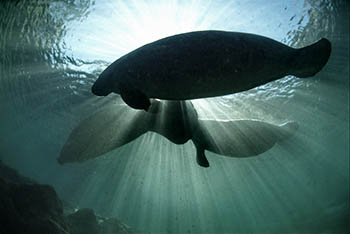The allure of mermaids has captivated human imagination for centuries, with tales of mystical creatures luring sailors with their enchanting songs. Among the many theories attempting to explain the origins of mermaid legends, one particularly intriguing hypothesis suggests a connection between manatees and mythical mermaids. We are going to dive into this theory and explore how folklore, science, and imagination all intersect into the theory.
The manatee-to-mermaid theory hypothesizes that sightings of manatees by sailors and coastal inhabitants might have contributed to the widespread belief in mermaids. Manatees are large aquatic mammals that are found in warm, shallow waters, and they share certain physical characteristics with the mythical mermaids. These gentle giants, also known as sea cows, possess rounded, human-like faces, plump bodies, and flipper-like limbs, which, when observed from a distance or under not-so-ideal conditions, could be mistaken for the upper body and tail of a human-like creature.
Throughout history, numerous accounts of mermaid sightings can be found in maritime folklore, often described by sailors who spent long stretches at sea. These encounters typically involved sightings of a creature with the upper body of a woman and the lower body of a fish. However, upon closer examination, it's believed that many of these sightings may have been misinterpretations of manatees or other marine animals.
One of the most famous instances of the manatee to mermaid theory is Christopher Columbus and his journal entry from 1493. He reported seeing mermaids off the coast of Hispaniola, which is modern-day Dominican Republic and Haiti. Columbus described them as “not half as beautiful as they are painted”. It is speculated that what Columbus saw were manatees. The physical characteristics he described very closely match those of these gentle marine mammals.
From a scientific perspective, the manatee-to-mermaid theory is supported by the fact that human perception can be influenced easily. Especially in unfamiliar or low-visibility environments, such as the open sea. Also, factors such as fatigue, dehydration, and desire for companionship during long voyages, could have easily contributed to the misidentification of manatees as mermaids. Sailors scanning the horizon for signs of land or other vessels, a glimpse of a manatee’s rounded head or flippers could have been enough to trigger the illusion of a humanoid figure in the distance.
Despite scientific explanations behind the manatee-to-mermaid theory, the appeal of mermaids in popular culture continues to thrive. The manatee-to-mermaid theory offers a fascinating insight into the complex relationship between folklore, science, and human perception. Whether inspired by manatees or purely the product of human imagination, the legend of the mermaid continues to enchant and captivate audiences around the world.

